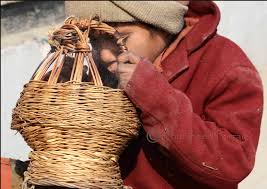Dr Qayum Hamid Changal
 I was born and brought up in Kashmir. I have seen, heard and felt a lot of it. Magnificently crafted, it is an embodiment of Kashmiri art and culture. A fire pot with hot embers, it’s kept at ease beneath the traditional clothing Pheran to keep cold away. We call it Kanger, the name itself manifesting the chain of emotions attached to it. About six inches in diameter, it reaches a temperature of about 70 degree celsius, thus is a dominant provision during chilling winters to expel discomfort off our bodies. One may even address it as a mobile fireplace, cute and endearing.
I was born and brought up in Kashmir. I have seen, heard and felt a lot of it. Magnificently crafted, it is an embodiment of Kashmiri art and culture. A fire pot with hot embers, it’s kept at ease beneath the traditional clothing Pheran to keep cold away. We call it Kanger, the name itself manifesting the chain of emotions attached to it. About six inches in diameter, it reaches a temperature of about 70 degree celsius, thus is a dominant provision during chilling winters to expel discomfort off our bodies. One may even address it as a mobile fireplace, cute and endearing.
To explain the relationship between a Kanger and Kashur (Kashmiri), the famous Kashmiri proverb goes as, “What Laila was on Majnun’s bosom, Kanger to a Kashmiri.” Historians believe it was used in the time of the Mughal Empire. Whoever invented it, I’m grateful to that fertile minded person for without Kanger the life in winters would have been terrible. Agreed, that its main use is to keep us warm. But, with time, we people have learned its several purposes or functions. It an evolution, the constant expansion of its effectiveness and gradually we have learned to use it for other purposes too, and few abuses too come into consideration.
During my childhood, I used to place potato or carrot in its red hot embers. Roasted and very tasty, the aura too was mouth watering. We would also stow an egg in it, and then cherish our taste buds with its delish and finger-licking taste. My grandmother would place a tumbler of water or milk to warm it up. It’s not just me or my grandma, but people in Valley do harbour and adore Kanger for such purposes too.
According to folklore Izband (Harmal/Wild Rue Seeds) smoke wards off the evil eye. These seeds are placed inside the Kanger on red hot embers to explode with small popping noise releasing a fragrant smoke. This tradition is still followed in Kashmir, be it a wedding party, festive happy gathering or a house warming party.
Kanger is a multi-purpose unit, alongside used as a movable heater. It’s used in drying the clothes as well, especially of infants. Thus, it acts as a drier, like we have the one in our washing machines. The mechanism may be different, but the objective isn’t dissimilar at all. We don’t hesitate using it as a mark of protest to show our dissent or anger. It comprises of both verbal and physical. ‘Pyeye Kanger’ is often used as a word of bold disobedience, or sometimes a funny punch line as slang between the friends. And, by physical I meant some people don’t mind bombarding it on each other while fighting over some issue, could be minor too.
Often, Kanger is hurled on the police or forces during protests in Kashmir. It’s more dangerous and expressive both. By expressive I mean the fire that’s inside the heart of a protestor is cannonaded outside too. I still remember a couple of years ago there was a protest against load shedding in my hometown. And, I heard one old man proudly shouting out to his friend, “Aaze chalve mei naar Kanger bijli mehkamas buthis. Vanni dazzan temme te aasi yeyi gash.” (Today I hurled a new firepot at department of electricity. Now they will burn and we’ll get light). The quote is full of exasperation and aspiration.
At times, Kanger has to endure the perversion by the hands of old people. Annoyingly, they use it as a ‘spitting tray’ expectorate inside it, which I personally don’t like at all. But then, the fire pot replies back very cleverly. Especially in case of old people, by mistake of course, either they smoulder their clothes or ‘Pyjama’ drawstring. I guess Kanger believes in eye for an eye policy. On the serious note, if you don’t use it cautiously, it could be hazardous.
Its use is associated with “Kangri Cancer”, a type of Squamous Cell Carcinoma. Usually the location of it is lower abdomen and inner thighs where the heat of firepot reaches the most. The condition was described in 1881 by surgeons at the Kashmir Mission Hospital and its cause was recognized in the early 20th century. That is why it is adviced not to keep the firepot closer to your body, else consequences would be dangerous.
Kanger is our symbol of rich heritage, the patrimony of care and warmth, and being in the constant war against chilly winters. It is a hieroglyph that represents us, our culture, tradition and rich background. Above all, it is said if you don’t know how to use Kanger, then you are not Kashmiri at all. Noted Kashmiri intellectual Aga Ashraf Ali once laid out the criteria for being a genuine Kashmiri. He said, “A Kashmiri is the one who can shuffle a kangri (a fire pot filled with charcoal ambers) under a 10-kg quilt with his feet even in semi-sleep.”
The author can be mailed at qhchangal@gmail.com





